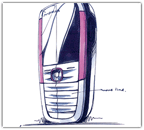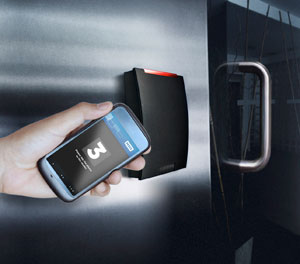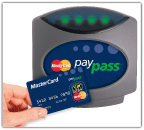Economy, standards stand in the way of NFC
20 April, 2009
category: Contactless, Financial, Library, NFC
 2009 was supposed to be the year of NFC but problems persist
2009 was supposed to be the year of NFC but problems persist
By Andy Williams, Associate Editor
Initially, 2009 was supposed to be a year of progress for Near Field Communication. But with tough economic times on tap many commercial rollouts will be pushed until at least 2010.
The tough economy is just one obstacle in the way of widespread NFC deployments. The lack of devices remains a problem and a clear business model on how everyone will make money off the technology has yet to be figured out.
But for 2009 the economy will likely be the primary hindrance. “One of the things that was noticeable at the American Public Transportation Association conference last year was the absence of announcements about NFC happening in 2009,” says Jeff Fonseca, director of business development and sales for one of NFC’s founders, NXP Semiconductors.
Still he remains upbeat. “From our standpoint we fully expect to have commercial solutions starting in 2010,” he adds. Originally, some commercial projects were set for 2009 but carriers have pushed back until 2010. In Europe, he believes, there will be some commercial deployments in 2009 with Nokia leading the way.
Randy Vanderhoof, Smart Card Alliance executive director, says it’s still difficult to determine how much impact the economy will have. “We’re still not sure what the depth of the economic recession is going to be long term,” he says. “The mobile business doesn’t seem to be significantly impacted so far in terms of the number of handsets being sold or the number of people adding phones. That market is still fairly strong.”
Mobile payments are getting a lot of attention from banks, which are trying to use mobile devices for payments, mobile alerts, access to account balances or to transfer funds, adds Vanderhoof. “All are taking different approaches to mobile payments. There isn’t just one approach that seems to be getting attention.”
There have been plenty of NFC pilots involving transit and payments, although far fewer have been announced in recent months.
Payments in U.S., transit elsewhere
Based on the trials under way, Fonseca sees a split in NFC deployments so far, with transit dominating Europe and Asia and mobile payments strong in the U.S.
Fonseca believes transit will push NFC adoptions more in Europe because many agencies are already using contactless technology. These closed loop systems, with the contactless infrastructure already in place, can help jump start NFC, at least when it comes to riding trains or buses.
In the U.S., though, transit isn’t as appealing. It’s been difficult in the U.S. for NFC to gain a toehold in the transit market because the number of contactless deployments are limited compared to Europe. “You only have eight or nine major metro areas where there are major contactless infrastructures geared towards transit,” adds Fonseca.
Payments are a different story. “The thing that will drive NFC in the U.S. will be payments because it comes down to the reader infrastructure to support these payments,” Fonseca says. “You have some 400,000 contactless readers that have been installed as opposed to a couple years ago when you only had 30,000. As this continues to grow, you’ll see the opportunity for mobile phone payments take off.”
Contactless reader deployment is an advantage because NFC isn’t starting from zero, says Peter Preuss, chairman of the NFC Forum Marketing Committee. “We’re just evolving the technology (from use of traditional contactless to NFC),” he says. “We know of 65 projects around the world using one of the standards of the NFC Forum.”
Preuss, a Nokia senior manager responsible for NFC business development in Central and Eastern Europe, says the forum is doing its best to make NFC interoperable. “We’ve released some 11 specifications and we’re working on a compliance program so that all these NFC devices will work together.”
Even though NFC is still in an early market stage, Preuss sees the first commercial deployments occurring in the public transit industry, followed by payments, vending machines, and other implementations, such as using NFC phones to buy tickets.
Of course, the definition of commercial deployment depends on whom you ask. “There are smaller ecosystems where you have full conversion roll-outs of NFC service,” says Preuss, “such as projects in India where we use NFC phones as bank terminals to give pensioners their pension. More than 250,000 people are getting their pensions through an NFC phone.”
Other uses coming online, Preuss predicts, are NFC-enabled digital cameras which can display photos on TV screen just by holding the camera near the screen. There also are NFC-enabled frozen food containers that can be held next to a microwave sensor to automatically set the cooking time.
“NFC is a young technology, and as with any new emerging technology, it takes time to implement,” adds Preuss. “If you compare NFC to Bluetooth, the first Bluetooth device took about seven years until it became mainstream.”
A positive, but potentially controversial boost
NFC recently received a boost from the Global System for Mobile communications Association (GSMA), a mobile industry trade group which last November called for full NFC functionality to be built into commercially-available handsets by mid-2009.
The GSMA board endorsed the single wire protocol (SWP) standard to provide the interface between the SIM card and the embedded NFC chipset. GSMA is also spearheading the Pay-Buy-Mobile initiative, a trial of NFC-enabled handsets.
Vanderhoof, however, sees the GSMA action as intensifying the battle between mobile operators (GSMA members) and phone manufacturers over who’s going to control the mobile device. “Mobile operators would like to see the applications driven by single wire protocol and stored in the SIM and not connected to the handset, because then mobile operators can replace handsets freely,” he says. “But mobile handset manufacturers are looking to have more of a direct interface within the handset itself.”
Mobile handset manufacturers don’t want to have NFC functionality resident in the SIM. “Which means there is no real added value coming back to the handset manufacturer for the revenue that will be generated,” adds Vanderhoof. “These sides have been fighting over the NFC turf for three years and neither side is willing to give in to the other without any clear revenue sharing model in place.” So far, such a model hasn’t been created.
Vanderhoof believes that both sides will battle to a stalemate until another technology or solution hits the market and presents a threat. Only then is a compromise likely to be found.
Stickers and other workarounds could help bridge the NFC gap
In the meantime, intermediate steps, such as a contactless sticker which can be affixed to cell phones, may have to do. Again, that would only apply to payments, treating the phone just like a contactless credit or debit card.
Fonseca also sees other pre-NFC deployments happening in the near future. These involve taking the micro SD slot in a cell phone and enabling it to facilitate contactless payments. It won’t be NFC, but it could go into legacy phones that can’t be upgraded to NFC, says Fonseca. “It allows a transit guy or merchant processor to deploy that type of service in a closed loop environment and that may help become a launch vehicle for NFC.”
It also presents a short-term solution to getting around a shortage of NFC equipment, Vanderhoof says. “It is a way of getting consumers who want to use their mobile phones a taste of what (contactless payments with a cell phone) will be like.”
These short-term solutions, however, miss the real value of NFC. “Which is to have applications downloaded and stored securely in the handset. None of those features will be available when NFC is in the form of a sticker. What stickers are doing is more or less adding another piece of payment media for contactless transactions in a different form factor,” says Vanderhoof.
While many want to look at NFC from a payments perspective, Preuss sees it as more of an enabling technology. “Various use cases have different business cases as well,” he adds. “Everyone needs to find a business case for the implementation, something where people can make money out of it.”
That’s one of the purposes of the NFC trials, to bring partners together for lessons learned. There was an example of this in the BART transit trial, says NXP’s Fonseca.
Last year, 230 Bay Area Rapid Transit riders in San Francisco were given a Sprint-provided, NFC compatible phone for them to pay to ride BART rails, the first transit agency in the U.S. to experiment with the new technology. The same phone could also be used to make purchases at Jack-in-the-Box restaurants or, for that matter, at any merchant capable of accepting normal contactless cards, such as those offered by MasterCard, Visa and American Express.
“They did see a lot of benefits from the user standpoint for them using the transit system more often and going to selected vendors they had access to such as Jack-In-the-Box. They are very bullish on those findings,” says Fonseca.
Obstacles to overcome
Despite all the trials there is a reluctance to fully commercialize NFC because of the things that have to take place, suggests Fonseca.
“If you’re going to have massive scale deployment that has to come from handsets,” he says. “Then you have to have those business models between the transit operator and phone operator to pay for that silicon that goes into the phone. Even transit guys understand that the integration hurdle needs to be jumped first.”
Another hurdle is securing those NFC transactions. There could also be a huge liability issue here, says Fonseca. “If I’m a bank issuing a card and there’s fraud, I have to carry that liability. Carriers can’t or won’t.”
Looked at another way, it resembles the classic chicken and egg type of paradox. It’s hard to discuss NFC security when there are so few devices out there. “There will always be a move to get applications to market and then figure out the security challenges that need to be addressed,” says Vanderhoof.
This has been true in most new technologies. “The emphasis has been in getting products to market and getting people to use them before the industry starts to address making them more secure,” says Vanderhoof. “If history follows, you’re going to see limited use of mobile applications to hit the market first and as adoption increases, attention will turn towards how do we make these applications more secure.”
When full commercial deployments of NFC do come about, Vanderhoof sees the U.S. being able to move quickly towards that technology. “We already have a large payments infrastructure in place and merchants are familiar with the technology,” he says. “Contactless as a payment platform has established significant roots in the U.S. and this leads me to believe that whenever mobile devices equipped with NFC become available, we will be able to ramp up fairly quickly in terms of NFC usage.
That’s not the case in Europe, however. “I question NFC pilots that are cropping up in other countries that are still early in the contactless payments lifecycle of having the same opportunities for rapid success … because they’re going to go through this same struggle of getting merchants to change their payment infrastructures,” says Vanderhoof.
In the end, it still boils down to one statistic. “We’re really dependent on having the mobile handset devices available for people to be able to take advantage of the speed and convenience that NFC offers,” says Vanderho




